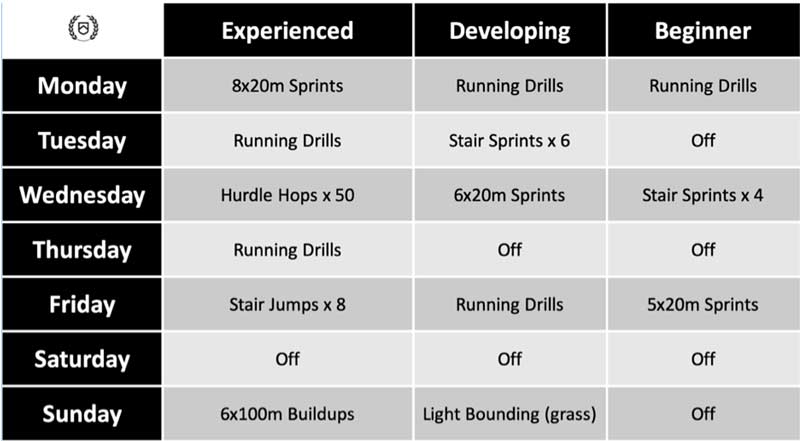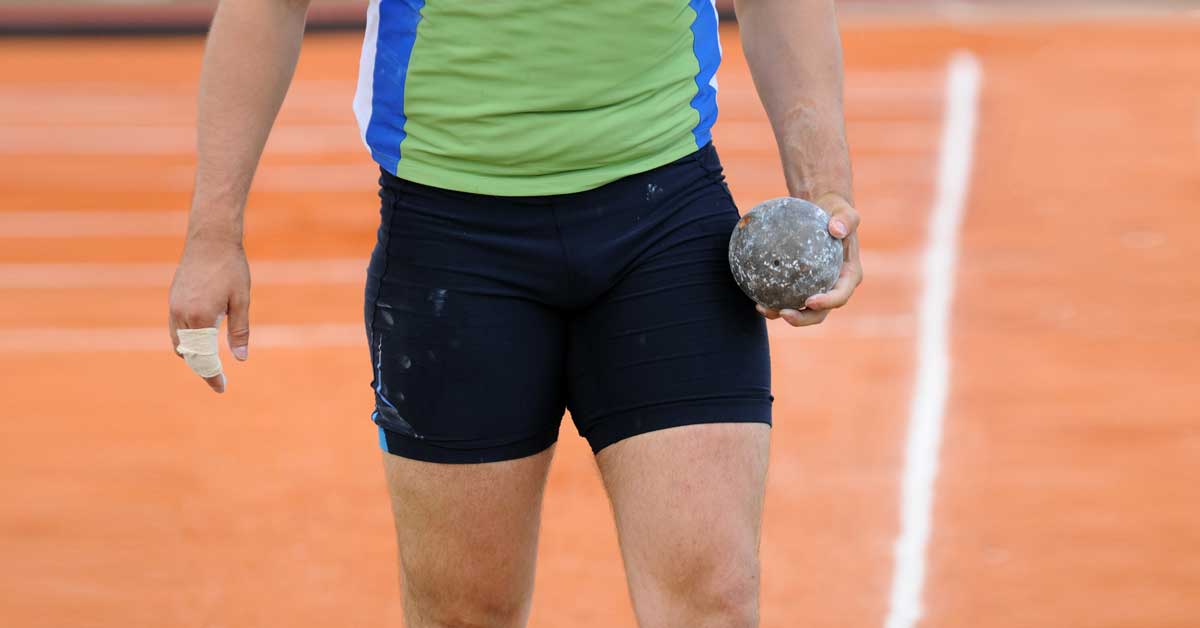[freelap-altis-logo]
Among sports, shot putting is considered one of the most powerful. To develop the massive amounts of power needed to succeed as a shot putter requires more than just throwing. Weight training is a very effective way to develop an athlete’s expression of power and can even benefit an athlete who is already considered very strong. Many of my former throwers, including previous shot put champions Reese Hoffa and Adam Nelson, have incorporated various forms of weight training over their careers to benefit their throwing performance.
Weight Training
Weight training is very important in the development of speed and power in the shot putter. It’s also crucial that shot putters realize it’s a method that supplements shot put training; it’s not a separate sport or discipline. The development of power through weight training must be done hand-in-hand with developing a thrower’s technique. If these two elements are not balanced, serious problems can occur with the thrower’s technique in the long term.
A thrower can develop their strength levels in the weight room at a very fast pace. This gives the athlete some quick short-term gains in throwing performance, especially for a big thrower who can get strong very fast. However, there is a potentially large downside to these short-term gains: relying on strength to throw far at an early age will decrease the efficiency of intra- and inter-muscular coordination regarding further development of shot put technique. As the shot putter continues to get stronger, the law of diminishing returns will kick in with increasing strength, and the gains in distance will quickly get smaller and smaller. When a shot putter relies entirely on strength to throw far, their long-term development may cap at a very early age.
When a shot putter relies entirely on strength to throw far, their long-term development may cap at a very early age. Share on XWhen setting up weight training throughout a season, the following considerations should be made:
- The principal weight training exercises involved in power development are the Olympic lifts (clean, snatch, overhead press/jerk variations) and the power lifts (bench press, squat variations, and deadlift variations). Throwers perform these exercises throughout training in some shape or form.
- The volume for these exercises is highest in the general and specific preparation phases while intensities are highest in the specific preparation phase and the pre-competition phase.
- As the shot putter becomes more advanced, they can lift heavier with more frequency, if desired, because their training capacity has had more time to develop.
Examples of appropriate exercises and their variations for shot putters are as follows:
- Bench press
- Incline bench press
- Front squat
- Box squat
- Push press
- Clean
- Snatch
- Speed clean and jerk
Of all the weight room exercises, the Olympic and power lifts will usually tax the thrower’s nervous system the most. For this reason, these lifts should be inserted into the training program around the throwing sessions, so the fatigue accumulated during the lifting sessions does not negatively affect the throwing sessions. More experienced throwers can recover from their lifting sessions with greater ease, however, and will be able to throw with less recovery time between sessions. This gives throwers more flexibility in their training.
Ancillary work such as core stability exercises, kettlebell or medicine ball exercises, fixed machine exercises, and bodybuilding and rehab exercises can be included in the program around the throwing and the Olympic and power lifts. Because most of the ancillary exercises involve slow and controlled motions that condition primarily Type I muscles, the shot putter can recover very fast from these exercise workouts.
Ancillary exercises are performed primarily in the general preparation and specific preparation phases. The number of ancillary activities will taper off greatly once the thrower enters the pre-competition and competition stages to allow more focus on the throws training.
Examples of ancillary exercises for the shot putter are:
- Neider press
- Med ball throws for height with a jump between
- Power position stand throws with med ball
- Russian twists
- Walking twists
- Plyometric push-ups
- Side ball slings with med ball
Generally speaking, the rotational shot putter relies less on strength training compared to the glider because the glider needs greater power to generate a large stand throw. The rotator’s technique is more complex and more timing-based. For these reasons, the weight training plans for the rotator and the glider are not the same, even though the throwers may be at the same performance level.
Weight training plans for the rotator and the glider are not the same, even though the throwers are at the same performance level. Share on XAdjust the lifting volume in relation to the throwing volume. Since throwing is a form of weight training (where one moves a light weight very fast), one should keep careful track of the throwing relative to the lifting volume. When one goes up, the other will usually have to go down. Both types of volume cannot stay high for very long; otherwise, the risk of injury greatly increases.
Running and Jumping
Running and jumping are essential parts of power and speed training for the shot putter. However, due to the shot putter’s large size (especially compared to the other throwing disciplines), one must exercise caution to make sure that overtraining does not occur.
The approach to running and jumping may differ greatly based on the type of shot putter. Leaner, more athletic shot putters may start off being able to handle large amounts of running and jumping without the onset of overuse injuries, such as patellar tendonitis or shin splints. As they put on mass and mature, they may have to scale back on the volume of running and jumping because of the extra weight they’ve put on.
Conversely, larger shot putters may not be able to run and jump as well at younger training ages due to a low bodyweight-to-strength ratio. As they progress in their training levels, they may improve their bodyweight-to strength-ratio and have the ability to increase the amounts of running and plyometrics.
Regardless of the type of thrower, one must progressively add the running and plyometrics so it balances in with the throwing and lifting. Most running regimens will consist of short, explosive runs between 10 to 100 meters, with the vast majority of the sprints being 40m or less. Because of the nature of the shot putting movement, sprints that last only 3-5 seconds are all that’s necessary to develop the type of explosive power needed to carry over into the throw.
Longer, more sustained running can occur during general preparation. However, when more specific training occurs as the season approaches, the longer runs will not integrate well with maximal explosive training. They must be reduced to short explosive sprints.
Plyometric and jumping programs should complement the type of lifting and throwing performed during a given period, and ground contacts should be measured to monitor the volume of these exercises. High-intensity plyometrics should only last for short periods during strategically placed sections of the training program. The high-intensity sessions usually occur in the pre-competition phase and the competition phase a few weeks before the major competitions. One can include lower level plyometrics at all times of the year.
Shot putters with higher training capacities can handle higher-level plyometrics; this is one trend that happens as a shot putter develops their power levels over the years.
They should be careful, however, to make sure that the volume does not go up too much when doing high-level plyometrics because it can lead to injury very quickly.

Remember: The Sport Comes First
Weight training is a great complement to a thrower’s ability to express power. Coaches and athletes, however, should be very clear that weight training is a method to supplement shot put training and is not a separate sport or discipline. Awareness of the law of diminishing returns is key when considering the question, “How strong is strong enough?” One also needs to give due thought to the reliance on strength training in the rotational versus glide technique.
Coaches and athletes should be very clear that weight training is a method to supplement shot put training and is not a separate sport or discipline. Share on XExercise caution when planning strength training in a long-term development program: perform due diligence when selecting the most appropriate exercises to include and when planning the undulation of their respective volumes and intensities over the training year.
Running and jumping activities also form essential elements of power and speed training for the shot putter. Once again, exercise caution and put into place appropriate loading strategies. Remember, supplementary power and speed training is designed to complement the thrower’s ability to throw—it is not a sport unto itself!







11 comments
Mercedes Elizabeth Belli
Looking for individual shot out coaching in SoCal for my son. Could you offer any recommendations?
Frank
I am a 65M masters recreational athlete.
I am wary of getting injured from weight, running, and jump training.
I made a shot put throw net in my backyard where the ball rolls back to me like a bowling ball.
Can i just make 60 throws every other day of varying levels of intensity(timing, form, and strenght development) to be sure my whole training time is devotedly sports specific?
Esmeralda Anderson Muniz-Rios
Hi my name is Esmeralda and I did shot put in high school for special Olympics and I broke the men & women record I loved it but I really want to do it again but I don’t know where to go to start shot put again can you please help me
Gulsah
Thanks coach 🙋🏻♀️ very helpful Example of a week’s training for the jumping and running workouts.
eke yunusa
you are really good. thanks for the advice.
David McEachern
Coach,
the information you have provided is extremely helpful and I will be implementing this into my young high school throwers. Thank You!
Coach G
Hi.
I have to HS thrower who is 5 months post knee arthroscopy. She is experiencing fatigue between throwing events. The first throwing event is fine but the second event suffers. I will be looking into her lifting routine to ensure it’s balanced and not the culprit. Should it not be the only culprit, are there any recovery methods or exercises that can help her recover between events.
Ounda caleb
A very useful content especially to me as a beginner coach in throws and sprint
Elvis
You’re a good coach love you😍
Tim B.
Thanks…very helpful. I am a 65 year old male that was a thrower in HS….now am planning to compete in the Senior Games…Shot Put. Any base suggestions?
Thanks.
Tim
Ramsamy
I need your advice concerning an athlete preparing for Paralympic games